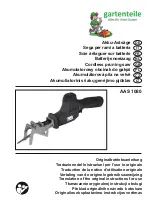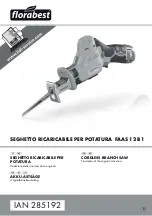
4.2.3.
fit the other leg to the shelf (do not fully tighten the screws yet), see fig.3.
4.2.4.
Fit the corner brackets inside each leg as shown using nut, bolt and two washers, see fig.4.
4.2.5.
The wheel bracket (174) is bolted on using the corner bracket bolts, onto the end opposite to where the handle will fit on (14), see
fig.5
4.2.6.
turn the stand the correct way up.
4.2.7.
using the help of at least two people, lift the saw onto the top of the stand. make sure the motor is at the end with the wheel
bracket.
4.2.8.
level the shelf and tighten its screws.
4.2.9.
make sure that the other person(s) steadies the saw until all six bolts that hold the saw onto the stand are tightened. it is
unstable until completed.
4.2.10.
double check that all bolts and screws are tight. the saw should now be stable.
4.2.11. f
it the handle to the opposite end to the wheel bracket see fig.6. Insert split pins into the ends of the handle and open them up to
prevent it from falling out.
4.2.12. f
it the wheels (with the face indicated in fig.7) against the wheel bracket. Secure with split pins in the end of the axle and behind
the bracket each side.
4.3.
fit belt guard
4.3.1.
Remove the two screws and the bolt as indicated by white arrows in fig.8.
4.3.2.
Before fixing down the pulley cover fit the grommet to the microswitch power cable and insert the grommet into the pulley cover.
secure it inside the pulley cover with its locknut. Adjust the position of the cable within the grommet to allow for the correct length
of cable inside the pulley cover for the microswitch to be correctly positioned, see fig.9.
4.3.3.
screw down the pulley cover.
fig.4
fig.5
fig.6
fig.7
fig.8
fig.9
Original Language Version
© Jack sealey limited
s
M5.V3 Issue:7(H, F)13/02/18



























